Recently, the World Health Organization (WHO) released a report on the elimination of trans fat worldwide in 2022, which illustrates the achievements made in achieving the goal of eliminating industrially produced trans fatty acids worldwide by 2023. The authorities of Japan, Canada and other countries have also released relevant policies on trans fatty acids in recent years. Hong Kong region will officially ban "partially hydrogenated oil" this year. Under this background, Antion sorts out the key regulations related to trans fatty acids in China, for reference by enterprises.
Regulations on trans fatty acids
GB 28050-2011 National Food Safety Standard General Rules for Nutrition Labeling of Prepackaged Foods
GB 13432-2013 National Food Safety Standard Labeling of Prepackaged Foods for Special Dietary Uses
GB 10765-2021 National Food Safety Standard Infant Formula
GB 10766-2021 National Food Safety Standard Older Infant Formula
GB 10767-2021 National Food Safety Standard Young Children Formula
GB 10769-2010 National Food Safety Standard Cereal-based Complementary Foods for Infants and Young Children
GB 10770-2010 National Food Safety Standard Canned Complementary Foods for Infants and Young Children
GB 5009.257-2016 National Food Safety Standard Determination of Trans Fatty Acids in Foods
GB 5413.36-2010 National Food Safety Standard Determination of Trans Fatty Acids in Foods for Infants and Young Children, Milk and Milk Products
Expert Interpretation of Trans Fatty Acid Management and Related Knowledge (2010-11-20)
Management and labeling of trans fatty acids
For general food, GB 28050-2011 National Food Safety Standard General Rules for Nutrition Labeling of Prepackaged Foods and its FAQs stipulate that the labeling of trans fatty acids includes mandatory labeling required in the standard and voluntary labeling by enterprises.
2.1 Mandatory labeling:
If hydrogenated and/or partially hydrogenated oil and fat are contained in food ingredients or used in the production process, the amount of trans fats (fatty acids) should be indicated in the nutrition information. Products whose ingredients are based on hydrogenated and/or partially hydrogenated oil, such as margarine, shortening, creamer and cocoa butter alternatives, should also be marked with content of trans fats (fatty acids). If claims are made for trans fatty acids, it's mandatory to indicate the content, which must comply with the requirements for claims in the standard.
2.2 Relevant requirement of claims are as follows:

2.3 Standard terms of function claim:
Daily intake of trans fatty acids should be no more than 2.2g. Excessive intake would be harmful to health.
Trans fatty acid intake should be less than 1% of total daily energy. Excessive intake would be harmful to health.
Excessive intake of trans fatty acids can raise blood cholesterol, which increases the risk of cardiovascular disease.
According to GB 28050-2011 National Food Safety Standard General Rules for Nutrition Labeling of Prepackaged Foods, when trans fats (fatty acids) are below "0" threshold value, that is ≤0.3g/100g (mL), the trans fatty acid content in the nutrition information can be marked as "0".
2.4 Voluntary labeling:
Naturally occurring trans fatty acids in foods are not required to be marked mandatorily, and enterprises may choose whether to do so voluntarily. If hydrogenated and/or partially hydrogenated oil and fats are not contained in food ingredients or are not used in the production process, enterprises may choose whether to mark the content of trans fatty acids or not.
For foods for special dietary uses, GB 13432-2013 National Food Safety Standard Labeling of Prepackaged Foods for Special Dietary Uses does not require mandatory labeling of the content of trans fatty acids, so enterprises may choose whether to do so voluntarily. However, the product standard for foods for special dietary uses such as GB 10765-2021 Infant Formula clearly requires that hydrogenated oil and fat should not be used, and the limits of trans fatty acids are specified as follows:

Source: Antion
Note: This article is compiled by Antion, please indicate our source if reprint it.